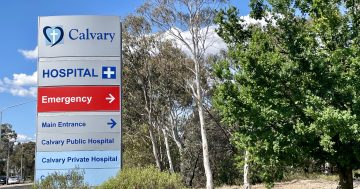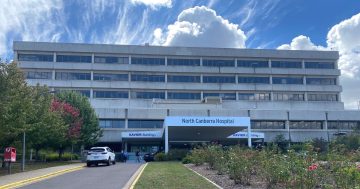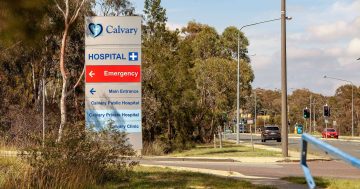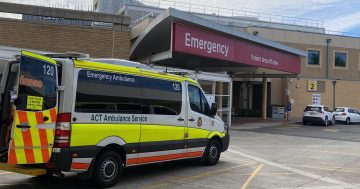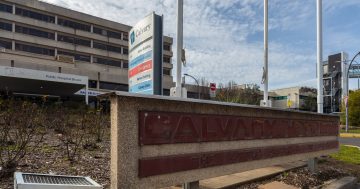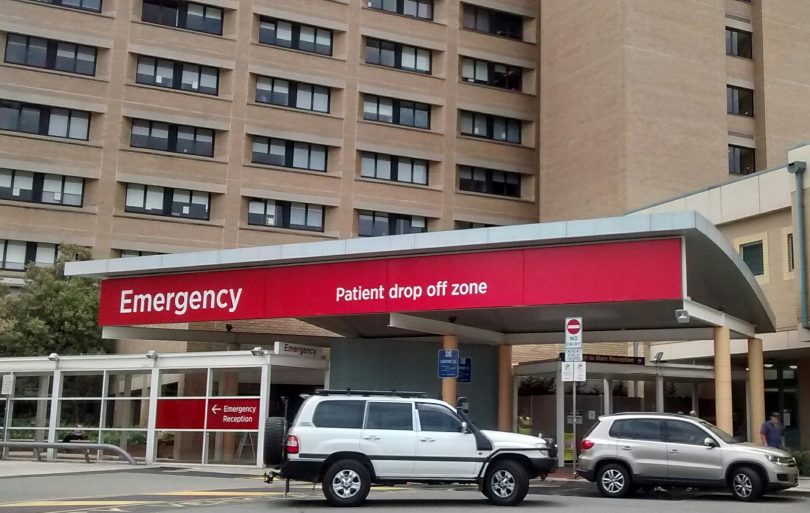
The Canberra Hospital. Emergency waiting times are still too high. Photo: Ian Bushnell.
ACT Health Minister Meegan Fitzharris insists the Territory’s public hospitals are on the right track to improve their performance despite the Report on Government Services showing waiting times and costs remain among the highest in the country.
But the Opposition says that despite a tripling in health expenditure, the number of patients receiving access to public hospital services in Canberra is lagging.
The report shows ACT emergency department waiting times are only better than that of the Northern Territory, with only 62 per cent of patients in 2016-17 seen on time, compared with the national figure of 73 per cent. Only 50 per cent of patients classified as urgent were seen on time, the equal worst result in the country with Queensland. Nationally, the figure is 66 per cent.
The Territory’s public hospitals remain the most costly with the average cost per emergency patient the highest in the country at $1,461, with the national average at $974. The average cost of care for an admitted patient is the second highest in the country at $6,347, behind the Northern Territory ($6,698). The national average was $5,199.
The number of people waiting too long for elective surgery remains high at 13.4 per cent of patients in 2016-17, the third worst result in the country behind Tasmania (27.1 per cent) and the Northern Territory (14.4 per cent), although the Minister said there were a record number of procedures last year.
Ms Fitzharris acknowledged there were areas for improvement but said the ACT was heading in the right direction and was confident that Emergency Department waiting times and costs would come down in future years.
“Overall, the Report on Government Services data shows that 62 per cent of patients were seen on time in the ACT in 2016-17. This was an improvement on the 51 per cent seen on time in 2012-13,” she said.
The Minister said ACT faced unique circumstances with the Canberra Hospital being one of the top 10 busiest emergency departments in Australia, and the major tertiary centre for the ACT and surrounding NSW regions, meaning a significant number of unwell NSW residents used its services.
“Calvary Public Hospital is a large, busy, hospital and is also responsible for meeting the needs of some urgent and complex cases. The performance of both ACT hospitals is comparable to peer group hospitals in other jurisdictions,” she said.
“For example, the Australian Institute of Health and Welfare Emergency Department Care Report for 2016-17 found that 71 per cent of ED presentations to Canberra Hospital had a length of stay of less than four hours. This compared with 68 per cent nationally within the principal referral women’s and children’s hospital peer group.”
Ms Fitzharris said Canberra was one of the healthiest cities in Australia and the Government would continue to invest strongly in the ACT health system and its staff, with a focus on providing a balanced mix of services.
She said the new University of Canberra Rehabilitation Hospital would play a key role in this, alleviating pressures at the other hospitals.
“The ACT has more nurses, midwives and medical practitioners per head of population than the national average,” she said. “We have a strong health workforce which will continue to grow. In last year’s budget, we delivered $443 million in new health investment, building on the $1.6 billion the ACT Government already invests in healthcare each year.”
She recommitted to the nurse-led Walk-in Centres that have come under fire for being too expensive, saying a third centre at Gungahlin would open soon, followed by centres in the Weston Creek and Woden area and the inner north.
She said the centres would take the pressure off the EDs and busy GPs, and promised greater collaboration and integration with GP services.
Opposition health spokesperson Vicki Dunne said that for years the ACT Government has been assuring the community that Canberra’s health system was improving, but the latest report reveals the opposite was true.
“In the last year, while non-salary costs have gone up 50 per cent, the number of patients seen has only gone up seven per cent. And total costs have gone up 30 per cent,” she said.
“Our services aren’t improving; we are seeing clear bottlenecks for patients accessing treatment services. Bottlenecks lead to increased waiting times, risking bad outcomes for patients.
“Ultimately, this could be a case of top-heavy bureaucratic administration that has lost touch with the immediate needs of patients. In any event, the only consistency that this government offers Canberrans is: pay more, get less.”
Elective surgery and Emergency Department data from 2015-16 has not been included in this report due to administrative issues, that prompted a System-wide Data Review.
A spokesperson for the Minister said the Review would be completed by March and that all data from 2015-16 would be made available for the 2019 Report on Government Services.













